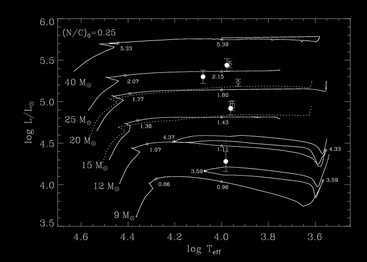
Massive stars of more than ~9 solar masses stay as early B or O-type
stars on the main sequence (the locus in the Hertzsprung-Russell diagram
where most stars assemble) for most of their lifetimes of a few
million years (for comparison, the lifetime of the sun is ~10 billion
years). After core hydrogen exhaustion they swith to core helium burning
as their main energy source. Their appearance hereby changes from a hot,
compact blue star to a cool, largely extended red supergiant. This
transition happens gradually over a time of several 104 years,
at roughly constant stellar luminosity. During this transition the stars
also cross the regime of late B, A and early F-type supergiants, where
they become the visually brightest normal stars in star-forming galaxies.
The theory of the evolution of massive stars has reached a high degree of
sophistication in the last years, stepping far beyond the models of classical
stellar evolution by accounting for the effects of mass-loss and rotation.
Such studies are currently performed by the
Geneva group,
in Utrecht
and here.
However, these models require comparison with observations in order to
verify whether they provide a realistic description of the relevant
physical processes.

Figure 9: Hertzsprung-Russell diagram with evolution tracks for
massive stars accounting for mass-loss and rotation according to Meynet &
Maeder (2000) and Maeder & Meynet (2001). The tracks were calculated at solar
(full line) and SMC metallicity (dotted line), for an initial rotational
velocity of 300 km/s. Starting with an initial solar value of 0.25,
nitrogen-over-carbon ratios (by mass fraction) are given at the end of
the main sequence evolution, during the blue supergiant stage, and for
the less massive stars after the first dredge-up and during the blue-loop
phase. The positions of some Galactic supergiants (filled circles),
NGC6822 (open square) and M31 objects (open diamonds), analysed in the
course of our work, are indicated. The derived observational abundance
ratios of the light elements - besides carbon and nitrogen also oxygen and
helium - allow stringent tests of the model predictions.
Here, our improvements to quantitative spectroscopy will help to provide
the observational constraints with unprecedented accuracy. This comprises
atmospheric parameters, and in consequence the fundamental stellar
parameters, as well as abundances of a few key elements (helium, carbon,
nitrogen and oxygen), which are tracers for rotationally induced chemical
mixing. The afore mentioned light elements (CNO) are catalysts in the
main fusion cycle taking place on the main sequence phase of massive stars,
while helium is the burning product from the fusion of 4 hydrogen atoms.
As with all catalysts, the total amount of CNO is not changed by the
fusion processes. However the individual abundances of C, N and O are
changed relative to each other due to different time-scales for the
nuclear processes. Turbulent mixing, induced by the stellar rotation, can
transport this material from the stellar core to the atmospheric layers,
where it gives rise to apparent abundance anomalies: slightly enhanced
helium and drastically increased nitrogen, with carbon significantly
and oxygen barely reduced. Some first results of our studies are shown in
Fig. 9. Many more analyses have to be performed, in order to sample the
whole parameter space. Observations of stars in other galaxies, at
metallicities different than solar, are in particular required to
study the impact of this important parameter on stellar evolution.
Note that certain stars can return to the blue after they
became a red supergiant, performing a so-called blue loop. Such
objects show markedly altered surface abundances of the light elements,
as they become fully convective during the red supergiant stage, a
highly efficient mechanism to mix core material to the stellar surface --
the so-called first dredge-up. Analyses of a larger number of
supergiants will help to constrain the extent of the blue-loop regime,
about which little is known at present -- even its existence is
questioned.
The final fate of all these supergiants is their violent death as
supernova, an event visible throughout half of the universe, as the stars
reach the luminosity of a hundred billion suns for a short time. This
explosions provide the heavy elements for new generations of stars,
planets, and eventually life itself.

